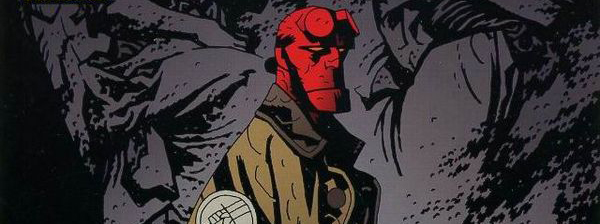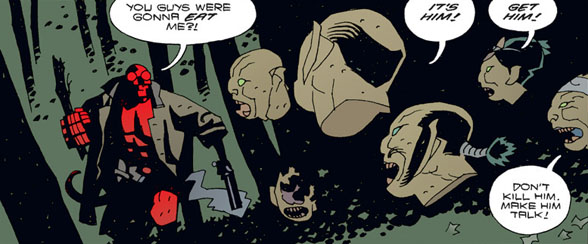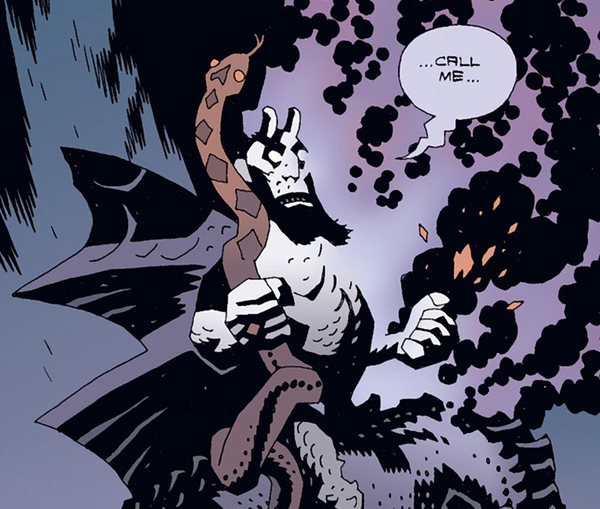
The Great Hellboy Re-Reading Project Part III: The Right Hand of Doom
I have recently begun an epic project: re-reading Mike Mignola’s complete Hellboy saga from the very beginning! What began as a series of sporadic mini-series and short-stories featuring the big red occult investigator has deepened over the past twenty years into what is, for my money, the richest and most consistently entertaining comic book universe of stories out there. Click here for part 1, in which I discussed the very first Hellboy tale: the four-part mini-series Seed of Destruction. Click here for part 2, in which I discussed The Wolves of Saint August, The Corpse and the Iron Shoes, and Wake the Devil.
Onward!
Almost Colossus (1997) — This two-issue mini-series serves as something of an epilogue for Wake the Devil, exploring what happened to Liz and Roger the Homonculus following their fateful encounter in Wake the Devil #3. Liz has been left alive but apparently sapped of her very life-force, leaving her as little more than a shell that is wasting away towards death. Meanwhile, Roger is loose in Romania, where he eventually finds a fellow Homonculus with a terrible plan, forcing him to choose whether he is a monster or a man.
Roger is a great character, an innocent heart in a monster’s body, and I can see why he caught on. I wasn’t sure where his story would go after he was introduced in Wake the Devil, but I was pleased, when I originally read this, to see that he was getting this two-issue story to focus on him. But, at the end of this mini-series, I never expected to see the character again. Who knew??
A Christmas Underground (from The Hellboy Christmas Special, 1997) — These days I am not so interested in the other stories in this collection, by other creators, but it opens with a humdinger of a Hellboy tale written & drawn by Mr. Mignola. This is a classic Hellboy short story, whimsical with a touch of sadness. The “happy ending” in which the kidnapped daughter is “saved” doesn’t wind up meaning that she is returned to life, once again pure and innocent, just that she is dead and her spirit free. Often in the Hellboy world that’s the best you can hope for. This short story is also chock full of wonderfully weird creatures and Hellboy hitting a lot of things. What more could I ask for?
Abe Sapien: Drums of the Dead (1998) — We can see in this one-shot the desire of Mr. Mignola (and perhaps, the team at Dark Horse Comics) to expand the Hellboy universe, but there were only so many comics that Mr. Mignola could write and draw himself. Thus we get this one-shot, written by Brian McDonald and illustrated by Derek Thompson. I assume Mr. Mignola must have had some involvement with the development of this story, but he’s not a credited writer. The result is a story that is very mediocre, missing that magic Mignola je ne sais quoi. Several years down the road, Mr. Mignola (and Scott Allie, editor at Dark Horse) would figure out how to expand the Hellboy universe and bring in other collaborators to increase the frequency of Hellboy books being published, while keeping Mr. Mignola involved and maintaining a consistency of feel. Not so here.
However, this one-shot does feature a phenomenal Hellboy short-story, written and illustrated by Mr. Mignola: Heads. Along with The Corpse, this is my very favorite Hellboy short-story. I love how Mr. Mignola is able to squeeze in so much Japanese folklore into these few pages, making it all mesh wonderfully with the Hellboy universe and resulting in a wonderfully unqiue, memorable tale. It’s scary and very, very funny, all at the same time. Amazing.
The Baba Yaga (1998) — I’d never read this short-story before this re-reading project. It turns out it was written and illustrated by Mr. Mignola specifically for the third Hellboy softcover collection, The Chined Coffin and Others. This story is a fine little story on its own, but when one considers the huge role the Baba Yaga is going to play in Hellboy’s future a decade down the road, in the Darkness Calls quadrilogy of stories, it becomes HUGE. This short story shows us the events that the Baba Yaga alluded to in Wake the Devil: the time when Hellboy shot out her eye. This story is also interesting in that it’s a rare example of Hellboy losing. We can understand why H.B. pursues the Baba Yaga, despite the local Russian villagers’ objections. But he doesn’t succeed in permanently defeating her, and arguably he makes things worse as we learn, at the story’s end, of the penance the Baba Yaga took on the village.
Batman/Hellboy/Starman (1999)– It’s hard to believe this crossover, written by James Robinson and illustrated by Mike Mignola, actually exists. It feels like a project that could only have existed in the early years of Hellboy, when Mr. Mignola was still finding his way. Somehow I could never envision a Hellboy-and-a-superhero crossover happening today. While this crossover tale has no relevance to the larger Hellboy saga, it sure is fun seeing Hellboy chatting with Batman, and to see Mike Mignola drawing Batman again.
The Right Hand of Doom (1998-2000)– I have been consistently following Hellboy via the monthly issues since the very beginning. But it was hard to always keep up with all the different Hellboy short stories that would pop up here and there. Hellboy: The Right Hand of Doom is the fourth trade paperback collection, and I picked it up because it collected a number of amazing Hellboy short stories that I had missed along the way. The collection is very cleverly divided into three sections.
“Part I: The Early Years” gives us: Pancakes, The Nature of the Beast, and King Vold. Pancakes is the most memorable, a very, very silly story of two-year-old Hellboy discovering pancakes, and thus falling in love forever with the human world. The Nature of the Beast is a mostly stand-alone story in which Hellboy kills a dragon/big lizard creature in England. The most notable aspect of this story is the idea of Hellboy’s blood turning into lillies where it fell, an idea that will become important down the line. King Vold is a great creepy story with a dangerous headless ghost.
“Part II: The Middle Years” gives us: Heads (which I have already discussed, above), Goodbye Mr. Tod, and The Varcolac. Goodbye Mr. Tod introduces the idea of a medium who uses ectoplasm to give form to the dead. This feels like an important precursor to Johann Kraus, who will be introduced soon in B.P.R.D.: Plague of Frogs. The Varcolac is a wonderful, weird vampire story.
“Part III: The Right Hand of Doom” gives us: The Right Hand of Doom and Box Full of Evil. The Right Hand of Doom is a very juicy short-story that returns our focus to the mystery of Hellboy’s stone right hand. Readers, and Hellboy himself, are reminded in this story of what we have learned of Hellboy’s purpose: his right hand is the key that will unlock the gates of Hell, making his destiny that of allowing the evil creatures of Hell to be set loose to destroy the world. Hellboy and readers might have thought that he was off the hook following the defeat of Hecate in Wake the Devil, but this story clarifies that this is not the case.
Box Full of Evil (1999) — Unlike most of the other stories in the collected edition of The Right Hand of Doom, I did read this two-issue mini-series when it was originally published. Continuing thematically from The Right Hand of Doom short-story, Hellboy’s Right Hand of Doom and his Beast of the Apocalypse destiny are front-and-center in this tale.
A short, evil little man named Igor Bromhead steals a box from a small house in Scotland and frees the minor demon, Ualac, who had been trapped within for centuries. Ualac tells Bromhead Hellboy’s secret name, Anung Un Rama, the knowledge of which, along with the proper incantations, gives Bromhead mastery over Hellboy. Meanwhile, Abe gets shot by a monkey. Things get really bad for our heroes, really fast.
At only two issues long, this is a very short mini-series, but quite a lot happens. We really get into Hellboy’s true nature, learning more about the Crown of the Apocalypse that he wears, which usually goes unseen to mortal eyes and which is a key to his destiny as the creature who will someday unlock the gates of Hell and unleash the apocalypse upon Earth. (Or not — whether this is in fact Hellboy’s true destiny is still unknown to readers, and it’s something I have been wondering about frequently in this re-read. Is the point of the decades-long Hellboy saga going to be Hellboy’s somehow finding a way to avoid his “destiny,” or of his eventually coming to grips with the fact that what has been often predicted about him cannot be changed?)
In issue #2, Hellboy meets for the first time the figures we have seen watching him; they give him the key to escaping Bromhead’s control. It’s interesting that these three help Hellboy. H.B. has spent his life battling (and usually killing) demons and mystical creatures just like them, and yet it seems that these three are on his side. I am intrigued as to why that would be. I suppose what we’re seeing here are the same sort of divisions in the mystical world as there are among humans on Earth. Not all such creatures are automatically evil, and these three seem far more civilized than the monstrous Ogdru Jahad and its “children.” (Also, now that we know the masked figure is Sir Edward Grey, we know he’s not a demon or mystical creature at all, right? Unless there are further twists to Grey’s story, which actually could be very possible. Either way, from all we have learned about Grey in the last two decades of Hellboy comics, he seems clearly to be a good guy. How he hooked up with these other two remains to be seen.)
Things get even more intriguing when Bromhead summons Astaroth, a Prince of Hell. I was expecting a hideous, monstrous creature, but what appears is a (slightly unearthly-looking) figure that resembles an old man with a beard. (We do see his true form in one panel at the end of the issue, but even then, for a Prince of Hell, he looks far less monstrous than I had expected.) He seems rather kindly to Hellboy. I’d love to learn more about this creature — he’s far less evil than I had expected! (I think we do wind up learning more about him many years later in the Hellboy in Hell series, but I don’t remember. Looking forward to seeing what comes of this as my re-read continues!)
Then there is Bromhead, who will go on to play a very important role in The Wild Hunt. I’m intrigued by Hellboy’s reference, here, to having met Bromhead previously. I don’t believe we have ever been told that tale; I wonder if we will someday. (I hope so!)
The original two issues of Box Full of Evil each had a back-up short-story. In issue #1, we get our very first Lobster Johnson story!! Talk about something that would gain in importance later on! The Killer in My Skull is a fun and weird pulpy adventure in which the Lobster winds up fighting a giant brain. What’s not to love?! Having now read many further Lobster Johnson adventures, there are several interesting things to note in this first Lobster story. First, it is set in 1938, which is after The Iron Prometheus and the Lobster’s having been co-opted by Memnan Saa. So although this is the very first published Lobster Johnson story, it is chronologically the LAST Lobster adventure we have read so far (until his death the next year (1939) at Hunte Castle, as chronicled in Conquerer Worm, the next Hellboy mini-series).
At this late point in the Lobster’s career, it’s interesting that the detectives just let him right into the crime scene. (I wonder if this is a result of Mr. Mignola’s ideas about the character changing in the years after he wrote this short story. Here he’s like Batman, welcomed in by the police. But in the Lobster Johnson comics from the last few years we’ve seen the Lobster having a far more antagonistic relationship with the police.) We also don’t see any of the Lobster’s usual coterie of allies, just one man in spectacles who isn’t named. (Have all of the Lobster’s allies already been killed in pursuit of Memnan Saa, as recounted much later in B.P.R.D.: The Black Goddess?)
I love that Zinco was apparently already operating back in ’38! Love those connections!
Box Full of Evil #2 has an Abe short-story, Abe Sapien Vs. Science, which is notable for the return of Roger! This was a big surprise for me at the time, though a pleasant one.
OK, that’s enough for today. I’ll be back soon to discuss one of my very favorite Hellboy mini-series, and one of the most important: Conquerer Worm.
The issues discussed in this post are collected in: Hellboy vol. 3: The Chained Coffin and Others and Hellboy vol. 4: The Right Hand of Doom.


